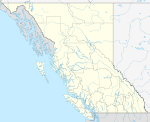Comox Valley Regional District
Comox Valley | |
|---|---|
| Comox Valley Regional District | |
|
Logo | |
 Location in British Columbia | |
| Country | Canada |
| Province | British Columbia |
| Administrative office location | Courtenay |
| Government | |
| • Type | Regional district |
| • Body | Board of directors |
| • Chair | Jesse Ketler |
| • Vice chair | Arzeena Hamir (B) |
| • Electoral areas |
|
| Area | |
| • Land | 1,699.90 km2 (656.34 sq mi) |
| Population (2016)[2] | |
| • Total | 66,527 |
| • Density | 39.1/km2 (101/sq mi) |
| Website | comoxvalleyrd.ca |
The Comox Valley Regional District is a regional district in British Columbia, Canada.[3] It was created on February 15, 2008, encompassing the southeastern portions of the former Regional District of Comox-Strathcona, and centred about the Comox Valley. The partition left the new Comox Valley Regional District with only 8.4 percent of the former Comox-Strathcona's land area, but 57.9 percent of its population. The CVRD covers an area of 2,425 square kilometres, of which 1,725 square kilometres is land (the remainder is water), and serves a population of 66,527 according to the 2016 Census.[4] The district borders the Strathcona Regional District to the northwest, the Alberni-Clayoquot Regional District to the southwest, and the Regional District of Nanaimo to the southeast, as well as the Powell River Regional District along the Strait of Georgia to the east.
Two Indian reserves, K'omoks Indian Reserve No. 1 and Puntledge Indian Reserve No. 2 lie within its territory but are outside its jurisdiction. The census divisions comprising the new Regional District are the city of Courtenay, the town of Comox, the village of Cumberland, Electoral Areas A, B, and C, and the two stated Indian reserves.
The administrative offices are in Courtenay, British Columbia.
Incorporated communities[]
Unincorporated communities[]
Comox Valley A[]
Known as the Baynes Sound-Denman/Hornby Islands electoral area, this electoral area includes the southern portion of the district, on the border with the Alberni-Clayoquot and Nanaimo Regional Districts.
According to the 2016 Canada Census:[5]
- Population: 7,293
- % Change (2011-2016): 4.5%
- Dwellings: 4,360
- Area (km²): 491.99
- Density (persons per km²): 14.7
Communities[]
Comox Valley B[]
Known as the Lazo North electoral area, this electoral area surrounds the town of Comox. It has no administrative or governmental function and is used only to select rural representatives to the regional district board.
According to the 2016 Census:
- Population: 7,095 (exclusive of any on-Indian Reserve residents)
- % Change (2011–2016): 2.2%
- Dwellings: 3,026
- Area (km²): 54.28
- Density (persons per km²): 117.9
Communities[]
Comox Valley C[]
Known as the Puntledge/Black Creek electoral area, it is located between Courtenay, Campbell River and Strathcona Provincial Park.
According to the 2016 Census:
- Population: 8,617 (exclusive of any residents of Indian Reserves)
- % Change (2011–2016): 3.5%
- Dwellings: 3,572
- Area (km²): 1073.96
- Density (persons per km²): 7.1
Communities[]
- Black Creek
- Merville
- Mount Washington
- Puntledge
Transit[]
Comox Valley Transit is the regional public transportation system, operated by Watson and Ash Transportation. Funding is provided under a partnership between the region and BC Transit, the provincial agency which plans and manages municipal transit systems.
See also[]
References[]
- ^ "Board Members & Structure". Retrieved July 9, 2019.
- ^ a b "Population and dwelling counts, for Canada, provinces and territories, and census divisions, 2016 and 2011 censuses – 100% data (British Columbia)". Statistics Canada. February 8, 2017. Retrieved July 9, 2019.
- ^ BC Names/GeoBC entry "Comox Valley Regional District
- ^ "Archived copy". Archived from the original on July 24, 2019. Retrieved August 28, 2019.
{{cite web}}: CS1 maint: archived copy as title (link) - ^ http://www.bcstats.gov.bc.ca/StatisticsBySubject/Census/2016Census/PopulationHousing/CensusSubdivisions.aspx
External links[]
| Wikimedia Commons has media related to Comox Valley Regional District. |
Coordinates: 49°45′00″N 125°00′00″W / 49.75000°N 125.00000°W
- Comox Valley Regional District
- Regional districts of British Columbia

